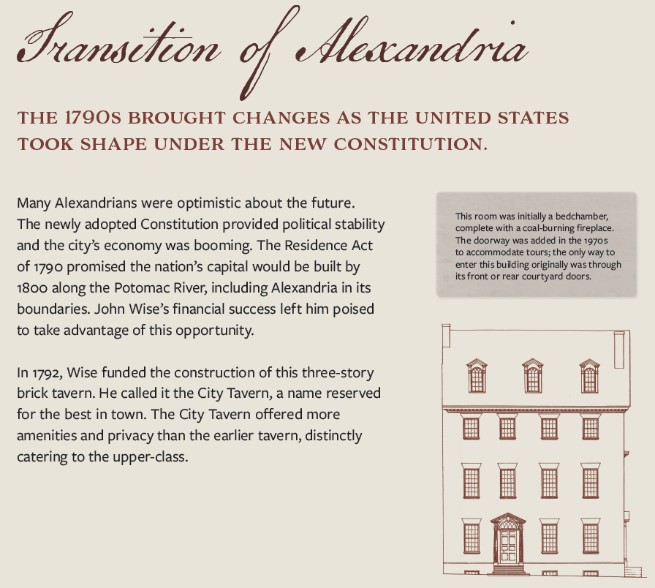
Tour Gadsby's Passage
Deep Dive Information
On-Site Exhibit

Transition of Alexandria
The 1790s brought changes as the United States took shape under the new Constitution.
Many Alexandrians were optimistic about the future. The newly adopted Constitution provided political stability and the city’s economy was booming. The Residence Act of 1790 promised the nation’s capital would be built by 1800 along the Potomac River, including Alexandria in its boundaries. John Wise’s financial success left him poised to take advantage of this opportunity.
In 1792, Wise funded the construction of this three-story brick tavern. He called it the City Tavern, a name reserved for the best in town. The City Tavern offered more amenities and privacy than the earlier tavern, distinctly catering to the upper-class.
This room was initially a bedchamber, complete with a coal-burning fireplace. The doorway was added in the 1970s to accommodate tours; the only way to enter this building originally was through its front or rear courtyard doors.

Timeline
Beyond Alexandria
| 1788 | U.S. Constitution ratified, replacing the Articles of Confederation. |
| 1789 | George Washington becomes the first U.S. president. |
| 1789 | Revolution erupts in France. |
| 1791 | The Bill of Rights is ratified, adding the first 10 amendments to the Constitution. |
| 1791 | The Haitian Revolution begins, sparking panic in white southerners who fear uprisings led by enslaved people. |
| 1794 | Eli Whitney patents the cotton gin, making cotton a cash crop and fueling demands for land and enslaved labor to the South and West. |
| 1796 | John Adams becomes the second U.S. president, marking a successful transition of power. |
| 1800 | Thomas Jefferson and Aaron Burr tie for the presidency. |
| 1800 | Jefferson narrowly elected by the House of Representatives. |
| 1803 | Jefferson’s Louisiana Purchase doubles the size of the U.S., continuing to strip Indigenous peoples of their land rights. |
| 1808 | U.S. law banning the transatlantic slave trade goes into effect. The domestic slave trade grows in response. |
In Alexandria
| 1790 | Residence Act passes, promising the nation’s capital would be built along the Potomac River. |
| 1796 | Alexandria ranks as seventh largest port in the U.S. |
| 1802 | Alexandria officially becomes Alexandria, D.C. As part of the capital, Alexandrians no longer have a vote in federal elections. |
| 1807 | U.S. Embargo Act prohibits Americans from shipping goods to foreign ports. Alexandria’s local economy suffers. |
| 1814 | Alexandria is briefly occupied by British forces during the War of 1812. In Washington, the British burn the White House. |
| 1828 | Alexandria establishes itself as the epicenter of the domestic slave trade when Franklin & Armfield open a slave-trading office on Duke Street. Thousands of enslaved people move through the city to the Deep South. |
| 1840 | Alexandrians begin petitioning to approve “retrocession,” the return of Alexandria to Virginia, driven by a lack of representation, funding, and political pressure to end the slave trade in the capital. |
| 1847 | Alexandria returns to Virginia. |
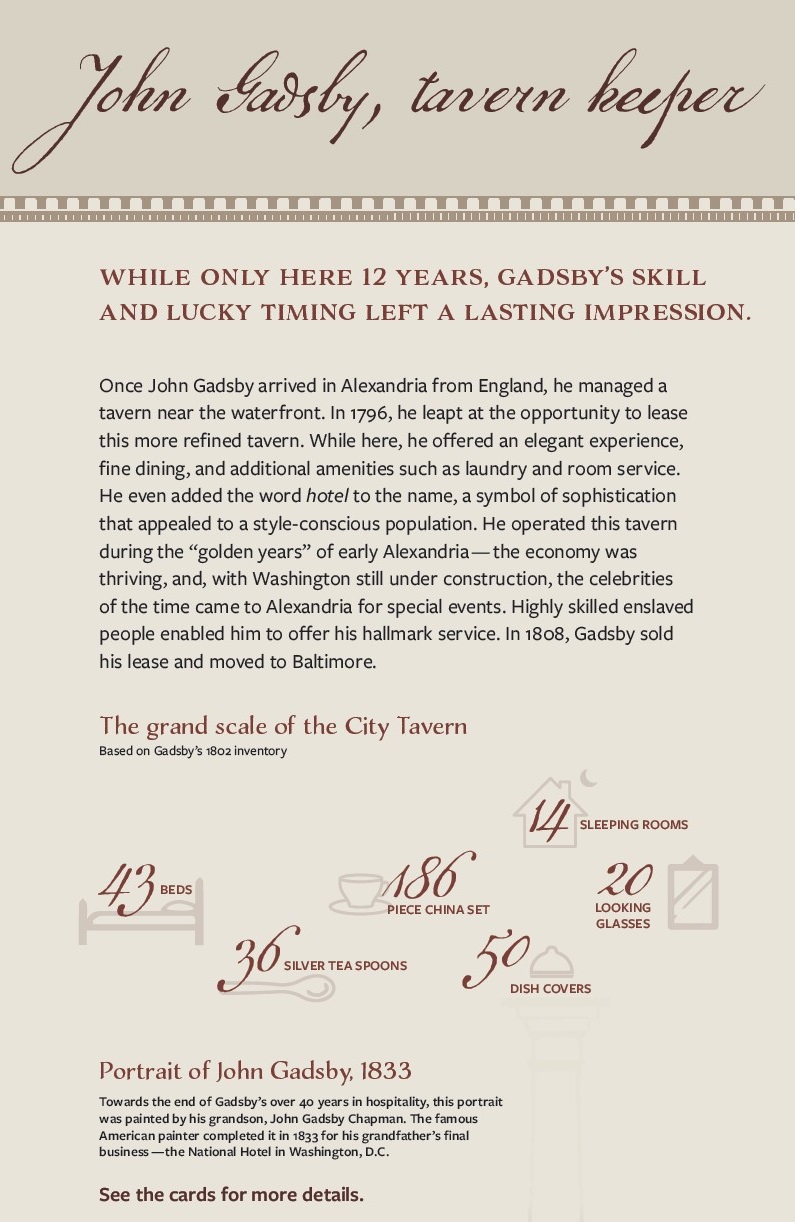
John Gadsby, tavern keeper
While only here 12 years, Gadsby’s skill and lucky timing left a lasting impression.
Once John Gadsby arrived in Alexandria from England, he managed a tavern near the waterfront. In 1796, he leapt at the opportunity to lease this more refined tavern. While here, he offered an elegant experience, fine dining, and additional amenities such as laundry and room service. He even added the word hotel to the name, a symbol of sophistication that appealed to a style-conscious population. He operated this tavern during the “golden years” of early Alexandria—the economy was thriving and, with Washington still under construction, the celebrities of the time came to Alexandria for special events. Highly skilled enslaved people enabled him to offer his hallmark service. In 1808, Gadsby sold his lease and moved to Baltimore.
The grand scale of the City Tavern:
Based on Gadsby’s 1802 inventory
- 43 beds
- 36 silver tea spoons
- 186 piece china set
- 50 dish covers
- 14 sleeping rooms
- 20 looking glasses
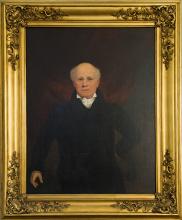
Portrait of John Gadsby, 1833
Towards the end of Gadsby’s over 40 years in hospitality, this portrait was painted by his grandson, John Gadsby Chapman. The famous American painter completed it in 1833 for his grandfather’s final business—the National Hotel in Washington, D.C.
Additional Signage
Ladder: Can you find where this ladder was used? Hint: look in the hallway.
In hallway: Look up! Remember the ladder? Musicians used it to reach the gallery during dancing assemblies. They would remain until the ladder was brought back out and they climbed down for a break. View the musician’s gallery from the Ballroom. Don’t miss the furnished Bedchamber down the hall.
Exhibit Cases
Traveling By Stage
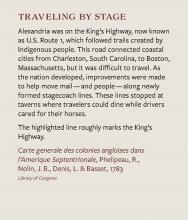
Alexandria was on the King’s Highway, now known as U.S. Route 1, which followed trails created by Indigenous people. This road connected coastal cities from Charleston, South Carolina, to Boston, Massachusetts, but it was difficult to travel. As the nation developed, improvements were made to help move mail—and people—along newly formed stagecoach lines. These lines stopped at taverns where travelers could dine while drivers cared for their horses.
The highlight line roughly marks the King’s Highway.
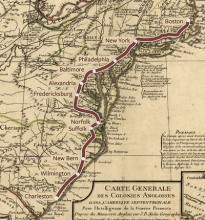
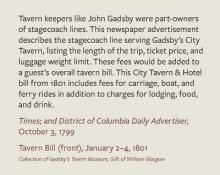
Tavern keepers like John Gadsby were part-owners of stagecoach lines. This newspaper advertisement describes the stagecoach line serving Gadsby’s City Tavern, listing the length of the trip, ticket price, and luggage weight limit. These fees would be added to a guests’ overall tavern bill. This City Tavern & Hotel bill from 1801 includes fees for carriage, boat, and ferry rides in addition to charges for lodging, food, and drink.
Times; and District of Columbia Daily Advertiser, October 3, 1799
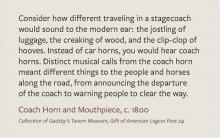
Consider how different traveling in a stagecoach would sound to the modern ear: the jostling of luggage, the creaking of wood, and the clip-clop of hooves. Instead of car horns, you would hear coach horns. Distinct musical calls from the coach horn meant different things to the people and horses along the road, from announcing the departure of the coach to warning people to clear the way.
Coach Horn and Mouthpiece, c. 1800

Service at the Tavern
Fragments of material culture and brief mentions in newspapers can help to envision the fashionable amenities offered at the City Tavern.
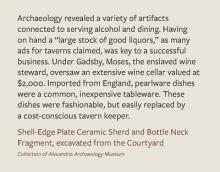
Archaeology revealed a variety of artifacts connected to serving alcohol and dining. Having on hand a “large stock of good liquors” as many ads for taverns claimed, was key to a successful business. Under Gadsby, Moses, the enslaved wine steward, oversaw an extensive wine cellar valued at $2,000. Imported from England, pearlware dishes were a common, inexpensive tableware. These dishes were fashionable, but easily replaced by a cost-conscious tavern keeper.
Shell-Edge Plate Ceramic Sherd and Bottle Neck Fragment, excavated from the Courtyard Collection of Alexandria Archaeology Museum
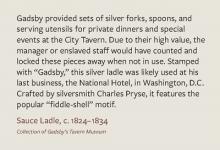
Gadsby provided sets of silver forks, spoons, and serving utensils for private dinners and special events a the City Tavern. Due to their high value, the manager or enslaved staff would have counted and locked these pieces away when not in use. Stamped with “Gadsby,” this silver ladle was likely used at his last business, the National Hotel, in Washington D.C. Crafted by silversmith Charles Pryse, it features the popular “fiddle-shell” motif.
Sauce Ladle, c. 1824-1834. Collection of Gadsby’s Tavern Museum
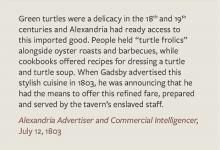
Green turtles were a delicacy in the 18th and 19th centuries and Alexandria had ready access to this imported good. People held “turtle frolics” alongside oyster roasts and barbecues, while cookbooks offered recipes for dressing a turtle and turtle soup. When Gadsby advertised this stylish cuisine in 1803, he was announcing that he had the means to offer this refined fare, prepared and served by the tavern’s enslaved staff.
Alexandria Advertiser and Commercial Intelligencer, July 12, 1803.
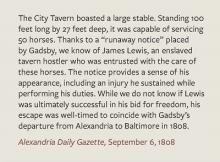
The City Tavern boasted a large stable. Standing 100 feet long by 27 feet deep, it was capable of servicing 50 horses. Thanks to a “runaway notice” placed by Gadsby, we know of James Lewis, an enslaved tavern hostler who was entrusted with the care of these horses. The notice provides a sense of his appearance, including an injury he sustained while performing his duties. While we do not know if Lewis was ultimately successful in his bid for freedom, his escape was well-timed to coincide with Gadsby’s departure from Alexandria to Baltimore in 1808.